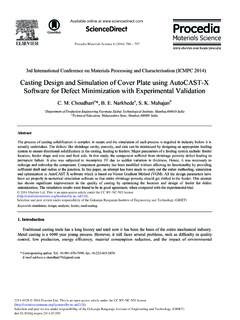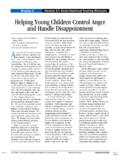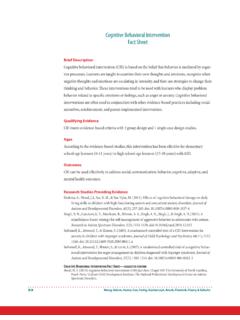Transcription of Managing Aggression Using Cognitive- Behavioral ...
1 See discussions, stats, and author profiles for this publication at: Aggression Using cognitive - Behavioral interventions : State of thePractice and Future DirectionsArticle in Behavorial Disorders January 2005 DOI: ,0823 authors, including:Some of the authors of this publication are also working on these related projects:integration of mindfulness training with Coping Power View projectFast Track View projectJohn LochmanUniversity of Alabama467 PUBLICATIONS 16,651 CITATIONS SEE PROFILEAnn P DaunicUniversity of Florida26 PUBLICATIONS 515 CITATIONS SEE PROFILEAll content following this page was uploaded by John Lochman on 13 May user has requested enhancement of the downloaded Disorders, 30 (3), 227 240 May 2005 / 227 Managing Aggression Using cognitive - Behavioral interventions : State of the Practice and Future DirectionsStephen W.
2 SmithUniversity of FloridaJohn E. LochmanUniversity of AlabamaAnn P. DaunicUniversity of Florida ABSTRACT: Education professionals consistently rank disruptive/aggressive student behavior as persistent and troubling, reporting various types of maladaptive behaviors ranging from talking out in class to assault. Researchers suggest that childhood Aggression accounts for a high proportion of the referrals to special education for emotional and Behavioral disorders (EBD). Teachers who work with students with EBD have traditionally relied on externally applied Behavioral techniques to manage aggressive behavior, but researchers more recently have studied interventions that use traditional Behavioral principles of behavior change along with cognitive components to increase student self-regulation, prevent or ameliorate aggressive behavior patterns, and increase constructive social interactions and long-term Behavioral change.
3 With this in mind, we examine Aggression from a contextual social cognitive perspective, describe the cognitive - Behavioral approach to intervention, provide examples of cognitive - Behavioral programs aimed at reducing Aggression and teaching appropriate replacement behaviors, and conclude with comments about the future direction of cognitive - Behavioral interventions in classrooms for students with EBDE ducation professionals contend that aggressive behaviors by students in public schools are widespread, necessitating an urgent, intensely calculated, and collaborative response from all stakeholders, including educators, parents, community members, and concerned citizens (e. g., Gladden, 2002). Students at all levels of the educational process can engage in maladaptive behavior that includes disrespect for authority, noncompliance, truancy, hyperactivity and inattention, lack of self-control, and verbal and physical Aggression .
4 In fact, educators rank violence and lack of discipline as two of their greatest concerns. In a recent Phi Delta Kappa/Gallup Poll (Rose & Gallup, 2004), lack of discipline was second only to lack of fi nancial support as the most serious problem in schools today, and teachers have identifi ed discipline as one of the most diffi cult challenges in the teaching profession (Information Needs Survey, 1997; Stephenson, Linfoot, & Martin, 2000). According to the U. S. Surgeon General (2001) ..the most urgent need now is a national resolve to confront the problem of youth violence systematically, Using research-based approaches, and to correct damaging myths and stereotypes that interfere with the task at hand (p.)
5 X). To complicate matters, numerous sources estimate that between 2% and 7% of the school population are classifi ed as having signifi cant, long-term emotional or Behavioral problems that often involve anger and Aggression and interfere with academic and social learning (Kauffman, 2004). Students who are identifi ed as in need of special education services for emotional or Behavioral disorders (EBD) programs accounted for approximately 2% of the school population in 2002 ( Department of Education, 2003), and these students frequently display externalizing behavior problems that may become part of an BehaviorDisorders_30(3).indd 35 BehaviorDisorders_30(3).indd 357/31/05 8:00:17 PM7/31/05 8:00:17 PM228 / May 2005 Behavioral Disorders, 30 (3), 227 240escalating spiral of confl ict within family, peer group, and eventually, marital relationships.
6 Because Aggression or other overt undesired behaviors frequently elicit negative responses, they can limit future opportunities for positive interactions and contribute to a persistent pattern of hostility and negative social status (Walker, Colvin, & Ramsey, 1995). Unfortunately, students who exhibit aggressive, antisocial behaviors tend to associate with peers with similar behaviors, thus perpetuating their aggressive behavior and increasing their rejection by nonaggressive peers (Stormshak et al., 1999).To counter Aggression , effective interventions in school settings for children and adolescents, especially those found in special education programs, are typically based on powerful Behavioral techniques, such as contingent reinforcement and behavior reduction procedures (Alberto & Troutman, 2001; Polsgrove & Smith, 2004).
7 Since the early 1960s, a wide variety of Behavioral change techniques applicable to school settings has been extensively developed and empirically validated under a range of conditions. When Behavioral methods such as token economies, Behavioral contracts, and contingent activities are well understood and skillfully applied, educators can change maladaptive student behavior and improve children s opportunities for academic and social success in school and later life. The use of Behavioral principles to address maladaptive behavior is not without some limitations. Polsgrove and Smith (2004) note that exclusive use of Behavioral strategies can foster dependence that may limit a student s capacity to resist negative external infl uences (Goldstein, 1988), advance the values and goals of institutional programs over those of individuals (Kazdin, 1978), and limit the Behavioral repertoires of students, especially those with EBD, rather than foster internal standards and mechanisms of Behavioral guidance.
8 In addition, natural environments such as classrooms often lack the quality of guidance or reliability of reinforcement strategies necessary for students to acquire, perform, and maintain appropriate behavior (Knitzer, Steinberg, & Fleisch, 1990; Wehby, Symons, Canale, & Go, 1998). Arguably, the most salient goal for students with EBD is self-regulation of behavior so that individuals can accurately interpret social cues, manage their emotional reactions to external stimuli, navigate challenging academic and social problems successfully, and achieve personal goals (Polsgrove & Smith, 2004). The importance of teaching students self-control can be overlooked in intervention packages designed to improve the behavior of students with EBD if these interventions are based solely on externally controlled, teacher-operated systems of reinforcement and punishment.
9 Logically, students develop self-control when they become an active participant in the development and strengthening of appropriate behaviors in a variety of environmental contexts. Accordingly, there is a compelling theoretical framework and an increasing body of research on cognitive - Behavioral interventions (CBI) that incorporate a blend of Behavioral strategies and cognitive components and are applicable in school settings. CBIs have been successful for children who exhibit aggressive behaviors that may signifi cantly interfere with their ability to achieve success in school and elsewhere (see Robinson, Smith, Miller, & Brownell, 1999). A contextual social- cognitive model that accounts for the development of serious antisocial behavior during the preadolescent and early adolescent years effectively serves as a conceptual framework for these interventions .
10 In this paper, we describe the contextual social- cognitive model of aggressive behavior and the cognitive - Behavioral approach to intervention, detail two examples of CBIs designed to counter Aggression with associated research, and offer commentary on the future direction of CBI in classrooms for students with Contextual Social- cognitive Model of AggressionChildhood Aggression is a stable behavior pattern, and a high level of impulsive, uncontrolled Aggression serves as a predictor for substance use, delinquency, and other negative outcomes during adolescence and adulthood (Bloomquist & Schnell, 2002; Connor, 2002). The timing of the initiation of aggressive behavior problems in children affects outcomes, and youth who engage in the most persistent, severe, and violent antisocial behavior are most likely to initiate delinquent behavior in childhood rather than adolescence (Lahey, Waldman, & McBurnett, 2001).



















